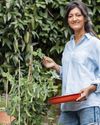
Growing even a little produce at home is a positive action towards a greener, rosier future as concerns around climate change and food security abound. No matter the size of our gardens, allotments, patios or windowsills, nurturing our own fruit and veg in a nature-friendly way can make a real difference for us, our plates and the planet. But it can be hard to see how our diet has an impact, so I asked food policy expert, Tim Lang, who is part of Gardeners' World Magazine's Growing Greener campaign panel, to explain.
Tim beleivesthe impact of food consumption on climate change has been played down by policymakers."The evidence on climate change (or global heating) has been building for 30 years," he says. "It's been ignored or downplayed as though a fictional 'someone' will come along and fix it.They won't, but we must. It's roll-upthe-sleeves time - put anxieties to one side and put your emotional, intellectual and practical energies into changing how you eat now as your contribution to action.
"With shop-bought food, you are almost certainly relying on largerscale growing. It will be less fresh, more packaged produce, with much hidden waste. Supermarket contracts force growers to jettison too much. Growing what you can at home always has an advantage over shop-bought groceries. Food systems drive 70 per cent of all water use, 26 per cent of greenhouse gases, most biodiversity loss and provide most jobs on the planet. It's so huge that the evidence has almost blinded policymakers."
Greener facts
Esta historia es de la edición March 2022 de Gardeners World.
Comience su prueba gratuita de Magzter GOLD de 7 días para acceder a miles de historias premium seleccionadas y a más de 9,000 revistas y periódicos.
Ya eres suscriptor ? Conectar
Esta historia es de la edición March 2022 de Gardeners World.
Comience su prueba gratuita de Magzter GOLD de 7 días para acceder a miles de historias premium seleccionadas y a más de 9,000 revistas y periódicos.
Ya eres suscriptor? Conectar

A new plot for tasty crops
Taking on a new allotment needn't be hard work. By simply following a few easy tips you can have bumper crops in no time, just like Alessandro Vitale

We love July
July is an island floating between the joy of June and the slightly fatigued month of August. It's a grown-up month: the year has shrugged off its adolescent exuberances, the weather is (hopefully) warm enough for ice cream to be one of your five a day, the sea should be swimmable without (too much) danger of hypothermia and thoughts will be of holiday shenanigans and family barbecues. School's out this month, the next tranche of glorious summer colour is washing across our borders and it's my birthday. Lots of reasons to give three rousing cheers for July!

YOUR PRUNING MONTH
Now, at the height of summer, Frances Tophill shows how to boost your plants' health and productivity with a timely cut

Hassle-free harvests
Flowers are out in abundance this month and for Jack Wallington, many of these blooms make delicious, low-effort pickings

Bite-sized bounties
Glorious doorstep harvests can easily turn into gluts, so let Rukmini Iyer's recipes help you savour every last bit

Upcycled outdoor living
Create unique and stylish garden features for minimal cost using reclaimed materials and simple DIY skills. Helen Riches shares four step-by-step projects and more inspiring eco tips

Secrets of a COLOURFUL GARDEN
Buildings and landscapes can play a vital role in supercharging your space, as Nick Bailey demonstrates

Greening up a city balcony
Looking for sustainable, small-space gardening ideas? Take inspiration from Oliver Hymans' transformed balcony garden in north-east London - now a lush, green haven for humans and wildlife

The dry and mighty garden
As we adapt our gardens to a more volatile climate, Alan Titchmarsh reveals how to create a drought-tolerant plot and picks his top plant performers

Nature knows best
Carol Klein explains how to choose plants for specific growing conditions, based on what has naturally adapted to thrive there